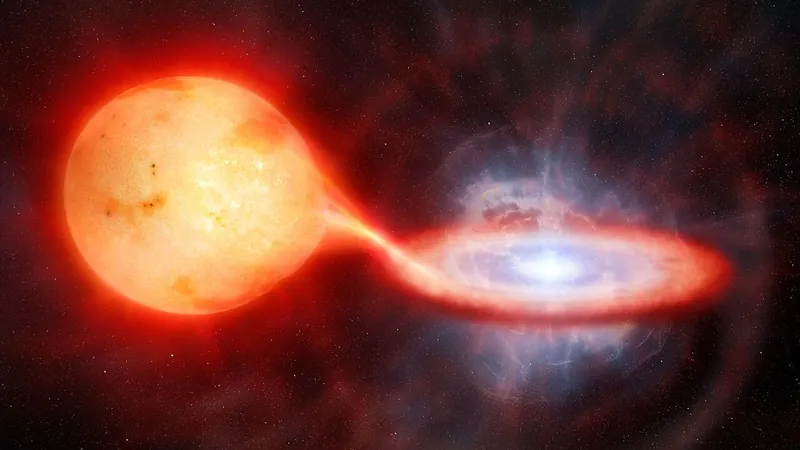
Unveiling the Universe's Hottest Nova: A Cosmic Explosive Wonder
2025-04-18
Author: Ming
A Record-Breaking Stellar Eruption Revealed
In a stunning revelation, astronomers have observed a repeating explosion in space that has shattered records, marking LMCN 1968-12a as the hottest nova ever documented! Nestled within the Large Magellanic Cloud, a neighboring galaxy to our Milky Way, this remarkable nova is the first of its kind to be studied in near-infrared light.
The Dance of Dead Stars: What Causes a Nova?
The magic happens when a white dwarf—a stellar remnant—is in a tight orbit with another star. As it pulls material from its companion, it sets the stage for a dazzling display known as a nova, which translates to "new" in Latin. This cosmic event results in a brilliant flash in the night sky, reminiscent of a newly formed star, only to fade away weeks or months later.
The Mechanics Behind the Explosion
As the white dwarf siphons gas from its younger counterpart, an accretion disk forms. This swirling mass of matter builds pressure and heat, triggering a thermonuclear runaway reaction when conditions become just right. The result? A breathtaking explosion that ejects material at astonishing speeds—hence the term 'nova.' When such explosions recur, as with LMCN 1968-12a, they do so at regular intervals, showcasing the relentless interaction between the two stars.
LMCN 1968-12a: A Cosmic Regular with Unique Properties
First discovered in 1968, LMCN 1968-12a has a white dwarf paired with a red subgiant star and erupts every four years. Since 1990, its violent outbursts have been anticipated, painting a dynamic picture of stellar evolution. The most recent eruption took place in August 2024, prompting further investigations using the powerful Magellan Baade and Gemini South telescopes in Chile.
The Discovery of Unprecedented Temperatures
Follow-up observations revealed some astonishing findings: a spike in ionized silicon that outshone the Sun by an astounding factor of 95 across all wavelengths! Yet, an unexpected absence of signatures from known elements like sulfur and phosphorus puzzled researchers.
Astronomer Tom Geballe remarked on this anomaly, pointing to the unusually high gas temperature in their models, which estimated the expelled material reached an astonishing 5.4 million degrees Fahrenheit (3 million degrees Celsius). Such extreme conditions are influenced by the lower metallicity of the Large Magellanic Cloud compared to our galaxy, creating a more intense explosive environment.
A Look Ahead: What This Means for Astronomy
The insights gained from LMCN 1968-12a not only deepen our understanding of nova phenomena but also highlight the potential of large telescopes like Gemini South to explore the universe's diverse chemical landscapes. As we continue to unravel the mysteries of these celestial explosions, the implications for our knowledge of stellar evolution and cosmic interactions grow ever more exciting!


 Brasil (PT)
Brasil (PT)
 Canada (EN)
Canada (EN)
 Chile (ES)
Chile (ES)
 Česko (CS)
Česko (CS)
 대한민국 (KO)
대한민국 (KO)
 España (ES)
España (ES)
 France (FR)
France (FR)
 Hong Kong (EN)
Hong Kong (EN)
 Italia (IT)
Italia (IT)
 日本 (JA)
日本 (JA)
 Magyarország (HU)
Magyarország (HU)
 Norge (NO)
Norge (NO)
 Polska (PL)
Polska (PL)
 Schweiz (DE)
Schweiz (DE)
 Singapore (EN)
Singapore (EN)
 Sverige (SV)
Sverige (SV)
 Suomi (FI)
Suomi (FI)
 Türkiye (TR)
Türkiye (TR)
 الإمارات العربية المتحدة (AR)
الإمارات العربية المتحدة (AR)